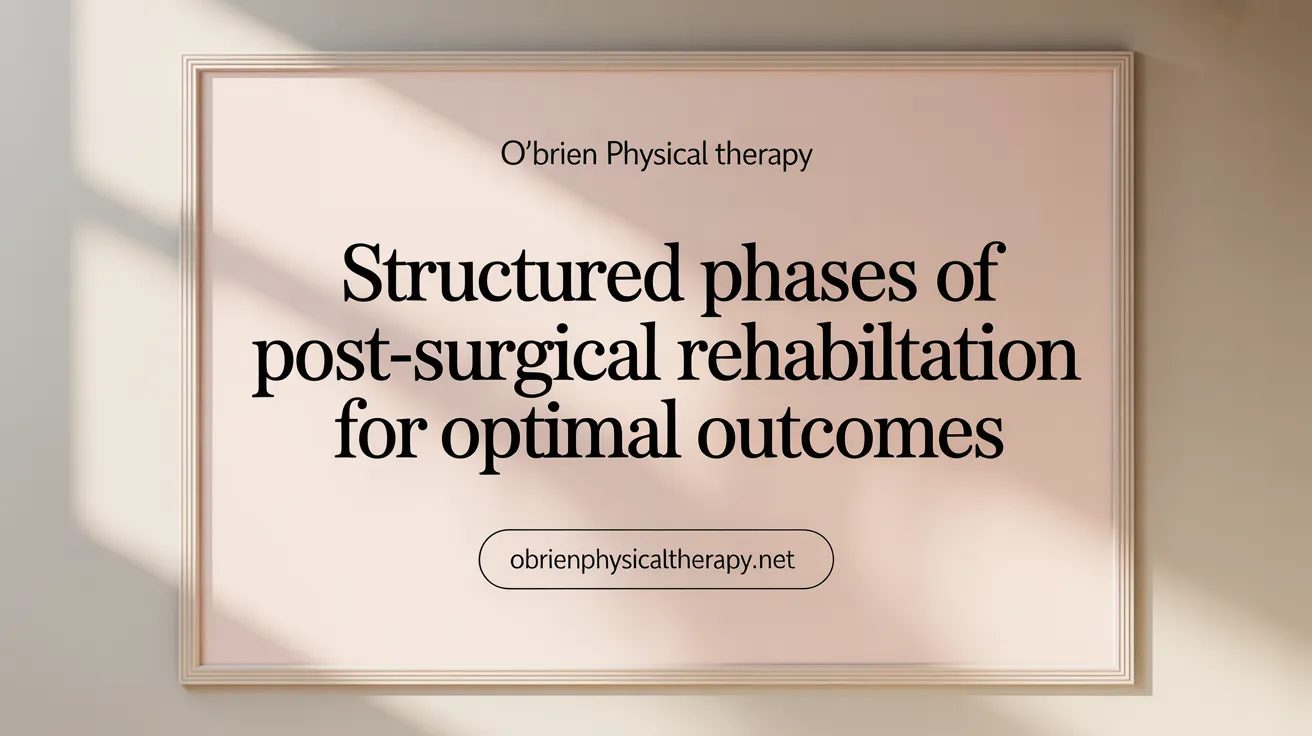The Crucial Role of Physical Therapy in Post-Surgical Recovery
Physical therapy (PT) has become an indispensable part of the recovery process following surgery, offering more than just passive care. It actively promotes healing, restores mobility, reduces pain, and helps patients regain independence. This article explores the multiple ways post-surgical physical therapy accelerates recovery and improves long-term outcomes across various types of surgeries.
Restoring Mobility and Function through Targeted Physical Therapy

How does physical therapy contribute to restoring function after surgery?
Physical therapy plays a critical role in helping patients regain strength, mobility, and overall function following surgery. Through physical therapy after surgery, targeted exercises after surgery, and manual therapy, patients gradually improve their range of motion, reduce stiffness, and enhance functional movements. This structured approach leads to greater independence in daily activities and a better quality of life.
What are the key methods used in post-surgical physical therapy?
Post-surgical physical therapy involves several specialized techniques:
- Therapeutic Exercises: Tailored to strengthen muscles and tendons around the surgical site, exercises focus on gradual progression to build endurance and flexibility. Learn more about therapeutic exercises for surgery recovery.
- Manual Therapy: Techniques such as massage and joint mobilization help to reduce pain, promote circulation, and improve tissue flexibility. For details on manual therapy techniques after surgery.
- Modalities: Tools like heat therapy, cold therapy, ultrasound, and electrical stimulation reduce inflammation, accelerate healing, and decrease discomfort.
Importance of gradual progression and range of motion improvements
Rehabilitation progresses in phases, beginning with gentle movements and advancing to more demanding exercises that restore full range of motion. This gradual increase ensures safe recovery while minimizing the risk of injury or complications such as muscle atrophy and joint stiffness. Read about the phases of post-surgery rehabilitation and progression.
Impact on daily activities and quality of life
Physical therapy’s comprehensive approach enables patients to resume daily tasks sooner. Improving joint mobility and muscle strength supports walking, climbing stairs, and participating in recreational activities, ultimately enhancing overall well-being and reducing the likelihood of chronic pain or long-term disability. Explore the benefits of physical therapy after surgery and how it improves quality of life post-surgery.
Pain Management and Complication Prevention through Physical Therapy

How does physical therapy help in managing post-surgical pain?
Physical therapy plays a crucial role in managing post-surgical pain by addressing muscle imbalances and reducing inflammation through various techniques. Therapists use manual therapy techniques, ice application, electrical stimulation, and other modalities to decrease swelling and soothe discomfort. This approach not only promotes natural tissue healing by improving blood circulation but also helps patients reduce their reliance on opioid or other pain medications, as discussed in Physical therapy for pain management.
In what ways does physical therapy reduce post-surgical complications?
Physical therapy helps prevent complications by encouraging gentle, early mobilization that counters muscle atrophy, stiffness, and blood clot formation. Targeted exercises and manual therapy minimize excessive scar tissue, which can otherwise restrict joint flexibility and cause pain. By restoring range of motion and strength, therapy supports safer and faster recovery while lowering risks of infection, joint stiffness, and other secondary issues associated with prolonged inactivity, as shown in preventing post-surgical complications.
Overall, physical therapy offers a safe, effective pathway to manage pain naturally and prevent common post-surgical complications. Its personalized interventions stimulate healing, maintain function, and enhance patient confidence during recovery through customized treatment plans and personalized physical therapy plans.
Phased Rehabilitation: Structuring Recovery for Optimal Results

What are the phases of post-surgical rehabilitation and their objectives?
Post-surgical rehabilitation is organized into four main phases that guide the healing process methodically. The immediate post-operative phase (days 1-7) centers on managing pain, swelling, and initiating gentle movements to prevent stiffness and blood clots. The early rehabilitation phase (weeks 1-4) focuses on restoring range of motion and starting light strengthening exercises. During the intermediate phase (weeks 4-8), patients work on muscle strengthening, improving balance, and regaining functional abilities required for daily activities. The advanced phase (weeks 8-12 and beyond) prepares patients to safely resume normal, work, and recreational activities with endurance and coordination training. For a comprehensive overview, see Phases of post-surgery rehabilitation.
Why is patient adherence and personalized therapy important?
Patient adherence to their rehabilitation program is crucial as it ensures steady progress and reduces the risk of setbacks or complications. Personalized therapy is equally vital because each surgery and patient is unique; physical therapists tailor treatments based on surgical specifics, individual health status, and recovery goals. Therapists continuously adjust exercises and modalities responding to patient progress and feedback, maximizing healing and functionality. Learn more about Personalized Physical Therapy Plans and Patient Education to understand the significance in recovery.
Role of Physical Therapists in Guiding Recovery
Physical therapists are essential in structuring rehabilitation phases and providing expert guidance. They assess patient condition at the outset, develop personalized plans, and supervise therapy sessions, ensuring safe exercise progression. Their expertise in musculoskeletal science allows them to incorporate techniques like manual therapy, modalities, and functional training targeted to optimize mobility, strength, and pain management throughout recovery.
Through structured phases, customized planning, and active patient participation under professional supervision, post-surgical rehabilitation promotes faster healing, reduced complications, and a successful return to daily life. For additional insights, see Post-Surgical Rehabilitation: What To Expect And How Physical Therapy Can Help.
Physical Therapy’s Impact on Functional Recovery and Quality of Life

How does physical therapy improve functional recovery and quality of life post-surgery?
Physical therapy plays a vital role in enhancing functional recovery after surgery by improving mobility, balance, coordination, and muscle strength. These improvements allow patients to regain independence and confidence in performing daily activities and recreational pursuits such as walking, climbing stairs, or biking more quickly and safely.
Therapeutic exercises, manual therapy, and targeted strengthening help restore joint flexibility and reduce stiffness, which are common postoperative challenges. Balance and proprioception training reduce fall risk and improve coordination, especially after joint replacements or neurological surgeries.
Beyond physical benefits, physical therapy supports mental health by alleviating fears of reinjury and promoting a sense of empowerment through gradual progress. Patient education on body mechanics and injury prevention further nurtures long-term well-being.
Studies show that consistent engagement in physical therapy leads to better long-term functional outcomes across a variety of surgeries, including orthopedic repairs, spinal procedures, and soft tissue reconstructions. This comprehensive recovery process ultimately enhances patients' quality of life by restoring their ability to return to work, hobbies, and social participation with less pain and greater autonomy.
Balancing the Benefits and Challenges of Post-Operative Physical Therapy

What does research say about the effectiveness and limitations of routine post-operative physical therapy?
Research indicates that routine in-patient physical therapy (PT) after surgery, such as spine operations, results in a modest increase in hospital stay length. However, this slight extension in stay comes alongside significant gains in patient mobility during hospitalization, including a notable increase in ambulation distance.
Interestingly, routine PT does not significantly reduce peri-operative complications or the rates of 30-day readmissions. This suggests while PT is crucial for improving functional recovery, it alone doesn't drastically affect short-term complication rates.
How do increased hospital stays weigh against mobility improvements?
The increase in hospital stay length should be viewed in light of the enhanced mobility benefits. Improved ambulation is vital to prevent muscle atrophy, joint stiffness, and other complications. It lays the foundation for regaining independence and improving long-term rehabilitation outcomes despite the longer inpatient time.
What about cost-effectiveness?
Evidence about the cost-effectiveness of immediate post-operative PT is mixed. Some studies highlight potential reductions in overall healthcare costs, but specific data regarding spine surgery is limited. Personalized PT plans tailored to individual needs and early initiation appear to optimize both clinical and economic outcomes.
How does collaborative care enhance post-surgical physical therapy?
Collaborative care models involving physical therapists, surgeons, and healthcare providers play a pivotal role. Coordinated efforts allow for customized treatment plans based on surgery type, patient condition, and recovery goals. This teamwork ensures seamless care, enhancing recovery speed, minimizing complications, and improving patient satisfaction.
In summary, while routine post-operative PT may modestly extend hospitalization, its benefits in mobility and functional restoration, particularly when delivered early and collaboratively, underscore its essential role in modern surgical recovery.
Maximizing Recovery Through Post-Surgical Physical Therapy
Physical therapy is a vital component of post-surgical recovery that accelerates healing, manages pain, and restores function effectively. By employing personalized, phased rehabilitation programs, PT enhances mobility, reduces complications, and improves quality of life. Though there may be modest increases in hospital stay with in-patient therapy, the significant gains in functional mobility justify its use. Collaboration between surgeons, physical therapists, and patients ensures optimized, comprehensive recovery strategies. Early and tailored physical therapy encourages not only physical healing but also empowers patients toward a confident return to their active lifestyles.
